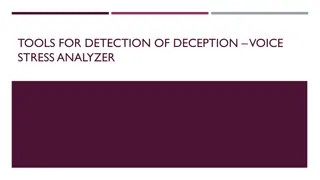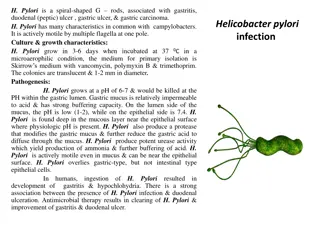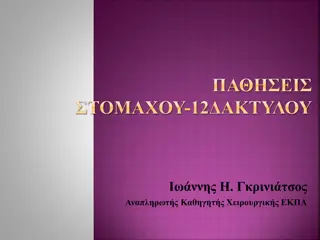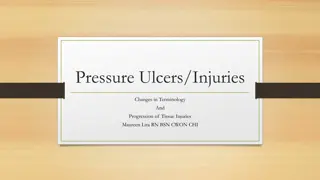Stress Ulcers: Definition, Epidemiology, and Management
Stress ulcers are acute lesions on the gastric mucosa caused by ischemia, commonly found in ICU patients. Learn about risk factors, pathophysiology, and initial management of gastric bleeding from stress ulcers.
Download Presentation

Please find below an Image/Link to download the presentation.
The content on the website is provided AS IS for your information and personal use only. It may not be sold, licensed, or shared on other websites without obtaining consent from the author.If you encounter any issues during the download, it is possible that the publisher has removed the file from their server.
You are allowed to download the files provided on this website for personal or commercial use, subject to the condition that they are used lawfully. All files are the property of their respective owners.
The content on the website is provided AS IS for your information and personal use only. It may not be sold, licensed, or shared on other websites without obtaining consent from the author.
E N D
Presentation Transcript
Endocrine system Fatima Obeidat, MD Department of Pathology and Laboratory Medicine
I. Thyroiditis 1. Chronic Lymphocytic (Hashimoto) Thyroiditis - Is the most common cause of hypothyroidism in developed countries where iodine levels are sufficient. - It is characterized by gradual thyroid failure secondary to autoimmune destruction of the thyroid gland
- It is most prevalent between the ages of 45 and 65 years and is more common in women - It can affect children
Clinically , 1.Painless thyroid enlargement 2.In the usual clinical course, hypothyroidism develops gradually.
NOTE: Patients with Hashimoto thyroiditis often 1. Have other autoimmune diseases 2. .Are at increased risk for the development of B cell non-Hodgkin lymphomas within the thyroid gland.
2. Subacute Granulomatous (de Quervains) Thyroiditis - Is much less common than Hashimoto disease - More frequently in women than in men. - Is believed to be caused by a viral infection and a majority of patients have a history of an upper respiratory infection just before the onset of thyroiditis.
Clinical Features : -Acute onset characterized by neck pain ( with swallowing) ,fever, and malaise. - Transient thyrotoxicosis may occur as a result of disruption of follicles and release of excessive hormones. - The leukocyte count is increased. - It is self-limited, with most patients returning to a euthyroid state within 6 to 8 weeks
3.Subacute Lymphocytic Thyroiditis : - Also is known as silent or painless thyroiditis. - And in a subset of patients the onset of disease follows pregnancy (postpartum thyroiditis).
- Mainly affects women, who present with a painless neck mass - Characterized by transient thyrotoxicosis and this initial phase of thyrotoxicosis is followed by return to euthyroid state within a few months.
4. Riedel thyroiditis,: -A rare disorder of unknown etiology, - Characterized by extensive fibrosis involving the thyroid and contiguous structures simulating a thyroid neoplasm clinically
II. GRAVES DISEASE - Is the most common cause of endogenous hyperthyroidism - It is characterized by a triad of manifestations: A. Thyrotoxicosis. - Caused by a diffusely enlarged, hyper-functional thyroid, is present in all cases.
B. Infiltrative ophthalmopathy with resultant exophthalmos in 40% of patients as a result of increased volume of the retroorbital connective tissues C. Infiltrative dermopathy pretibial myxedema of skin in about 10% of the cases
Laboratory findings in Graves disease - Elevated serum free T4and T3 and depressed serum TSH
III. DIFFUSE AND MULTINODULAR GOITER - Enlargement of the thyroid, or goiter, is the most common manifestation of thyroid diseases.
Mechanism : - The goiters reflect impaired synthesis of thyroid hormone often caused by dietary iodine deficiency and this leads to a compensatory rise in the serum TSH, which in turn causes hyperplasia of the follicular cells and, ultimately, gross enlargement of the thyroid gland .
- The compensatory increase in functional mass of the gland is enough to overcome the hormone deficiency, ensuring an euthyroid state in the vast majority of persons.
- If the underlying disorder is sufficiently severe (congenital biosynthetic defect), the compensatory responses may be inadequate to overcome the impairment in hormone synthesis, resulting in goitrous hypothyroidism .
Goiters can be endemic or sporadic. 1. Endemic goiter : - Occurs in geographic areas where the soil, water, and food supply contain little iodine. - The term endemic is used when goiters are present in more than 10% of the population in a given region.
2. Sporadic goiter : - Less common than endemic goiter. - Peak incidence in puberty or young adulthood, when there is an increased physiologic demand for T4. - It may be caused by several conditions, including :
a. Ingestion of substances that interfere with thyroid hormone synthesis , such as excessive calcium and vegetables such as cabbage, and cauliflower. b. Hereditary enzymatic defects that interfere with thyroid hormone synthesis (dyshormonogenetic goiter).
Clinical Features : a. The dominant features are mass effects of the goiter b. May cause airway obstruction, dysphagia, and compression of large vessels in the neck and upper thorax (so-called superior vena cava syndrome).
Note: - The incidence of malignancy in long-standing multinodular goiters is low (less than 5%) but not zero and concern for malignancy arises with goiters that demonstrate sudden changes in size or associated symptoms ( hoarseness of voice)
- Clinically ,the possibility of a cancer is of major concern in patients who present with thyroid nodules but fortunately, the majority of solitary nodules of the thyroid prove to be either a. Follicular adenomas b. A dominant nodule in multinodular goiter c. Simple cysts or foci of thyroiditis
Note: - Carcinomas of the thyroid, are uncommon, accounting for much less than 10% of solitary thyroid nodules - Several clinical criteria provide a clue to the nature of a given thyroid nodule: a. Solitary nodules, in general, are more likely to be neoplastic than are multiple nodules.
b. Nodules in younger patients are more likely to be neoplastic than are those in older patients. c. Nodules in males are more likely to be neoplastic than are those in females. d. A history of radiation therapy to the head and neck associated with an increased incidence of thyroid cancer mainly papillary carcinoma.
e. Nodules that take up radioactive iodine in imaging studies (hot nodules) are more likely to be benign than malignant Note: - It is the morphologic evaluation of a given thyroid nodule by pathological study of surgically resected thyroid tissue that provides the most definitive diagnosis
1. Follicular adenomas - Are benign neoplasms - Usually are solitary - Clinically present as painless nodules.























